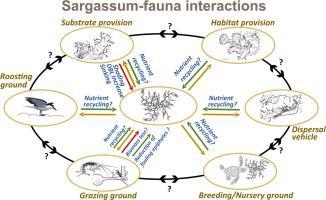亚热带和热带北大西洋全浮游马尾藻的区系关联研究进展
IF 4.5
1区 生物学
Q1 MARINE & FRESHWATER BIOLOGY
引用次数: 0
摘要
全海马尾藻属(此处为马尾藻)是生物多样性高海筏的基础海藻。浮筏为许多海洋物种提供了基质、庇护所、觅食和繁殖地,使它们成为公海上独特的群落。与其他远洋系统类似,与木筏相关的群落是动态的,内在可变的,并由木筏的动态以及海藻和相关动物群之间的相互作用来定义。生物多样性高,包括来自不同营养水平的生物,导致多种相互作用和复杂的食物网,这是本文的综述。此外,我们强调了漂浮马尾藻如何作为生态连通性的载体,影响遥远的生态系统,如沿海和深海栖息地。这些跨生态系统的相互作用通过生物运输、有机物输出和营养联系发生。了解这些联系是认识马尾藻筏更广泛的生态作用及其提供的多种生态系统服务的关键。本文章由计算机程序翻译,如有差异,请以英文原文为准。

Faunal associations of holopelagic Sargassum spp. in the subtropical and tropical northern Atlantic: A review
Holopelagic Sargassum spp. (Sargassum from hereon) are the founding seaweeds of biodiverse high-sea rafts. The floating rafts provide substrate, shelter, feeding-, and breeding grounds for numerous marine species, making them unique communities in the high seas. Similar to other pelagic systems, the community associated with the rafts is dynamic, inherently variable, and defined by the dynamics of the rafts and interactions between the seaweed and associated fauna. The high biodiversity, including organisms from different trophic levels, results in multiple interactions and complex food webs, which are covered in this review. Additionally, we highlight how floating Sargassum acts as a vector of ecological connectivity, influencing distant ecosystems such as coastal and deep-sea habitats. These cross-ecosystem interactions occur through organism transport, organic matter export and trophic linkages. Understanding these connections is key to recognizing the broader ecological role of Sargassum rafts and the multiple ecosystem services they provide.
求助全文
通过发布文献求助,成功后即可免费获取论文全文。
去求助
来源期刊

Harmful Algae
生物-海洋与淡水生物学
CiteScore
12.50
自引率
15.20%
发文量
122
审稿时长
7.5 months
期刊介绍:
This journal provides a forum to promote knowledge of harmful microalgae and macroalgae, including cyanobacteria, as well as monitoring, management and control of these organisms.
 求助内容:
求助内容: 应助结果提醒方式:
应助结果提醒方式:


